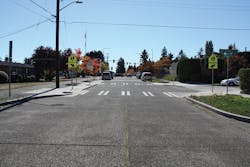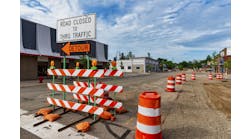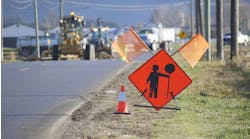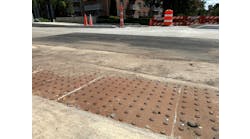The new protected pedestrian lane at South Park.
A small investment can change the face of a community. The Seattle Department of Transportation (SDOT) serves a diverse population, and recognizes the importance of celebrating that diversity in all its projects. In recent years, SDOT has been finding ways to highlight each community’s individual character in its small-scale pedestrian projects. The agency has completed numerous low-cost improvements that reflect the neighborhood character, create a sense of community and ownership and maintain the integrity and purpose of the project. This article focuses on projects that were designed and implemented with SDOT crews.
It is important for transportation professionals to think about the people for whom we are designing. The future of transportation engineering is not just about maximizing throughput, but is about building communities while safely moving goods, services and people. These projects are a few examples of how this can be accomplished as we embrace an exciting new era in the world of transportation.
Improved crosswalks at Roxhill Elementary School.
South Park
In the spring of 2016 SDOT’s engineers and planners came together to find a solution to the age-old battle of sidewalk versus tree. The South Park neighborhood in South Seattle had an arterial street with three blocks of street trees lining each side. Tree roots had caused uplifts in the sidewalk up to 3 ft high. In a few years, a sidewalk replacement project will create the space needed for the tree roots, and install natural drainage solutions, but an interim solution was needed.
The existing street was 42 ft long with one lane in each direction and on-street parking on both sides. Crews narrowed the travel lanes down to 10.5 ft, and implemented a parking-protected pedestrian lane. The new at-grade pedestrian path was delineated with wheelstops and flexible delineator posts, but something needed to be done at the intersections. Traditionally, SDOT has been making interim curb bulbs with a double 4-in. white lines and beige paint to designate the pedestrian space. For this project, something new was used to brighten up the pedestrian realm and incorporate a piece of the neighborhood. The solution was painted polka dots in the South Park Neighborhood Association’s colors.
It was as easy as picking out color chips, cutting stencils out of cardboard, marking the center of each polka dot, and using the paint sprayers to create a colorful and unique pedestrian space. Two colors were chosen, and each color had a different diameter circle. This allowed for a variegated design to make fading less obvious.
When the polka dots were presented to the neighborhood association, there was a definite change in the room. Residents went from being concerned about what the long-term capital project would look like, and how SDOT would accommodate both the trees and an accessible pedestrian space, to trusting that the agency was considering their needs in both the short and long term.
Roxhill Shooting Stars
Seattle is dedicated to creating safer routes for kids to be able to walk and bike to school. Schools are centers for the community, are a major part in the lives of our kids, and are the first formal community most of us experience in life. At an elementary school in West Seattle, crews helped enhance that sense of community and identity at Roxhill Elementary.
The original project was to install curb bulbs, ADA-compliant curb ramps and marked crosswalks in front of the school. There was a problem with people dropping off and blocking the crossings at the T-intersection directly in front of the school. Workers installed a bulb along the top edge of the T-intersection, but wanted to do something to enhance the bulb area. The school’s mascot is shooting stars. A rubber stamp of a star that would fill the 2-ft x 2-ft sidewalk squares was employed, and the contractor stamped out stars in a random pattern. (See this edition’s cover for an example.)
It was a subtle treatment that only added a few hours of labor and $100 for the stamp, but the feedback from the school was great. They loved the stars, and really appreciated that SDOT’s engineers and planners took the idea of school spirit into consideration.
A newly striped community crosswalk.
Community Crosswalks
One of SDOT’s new programs is community crosswalks. The first community crosswalks were installed in the Capitol Hill neighborhood, which has long been a gathering place for the LGBTQ community. Rainbow crosswalks were installed at major pedestrian crossings throughout the neighborhood using preformed thermoplastic. After the success of the first community crosswalks, other neighborhoods began to show interest.
One neighborhood in Central Seattle wanted community crosswalks so much that they went out and spray painted their own over existing white ladder ones. The neighborhood is traditionally of African descent and wanted the colors of the Pan African flag. SDOT heard the message, and decided to use funds from the community crosswalk program to fulfill the community’s desires, while still providing a highly visible pedestrian crossing. The crosswalks were remarked with preformed thermoplastic in the colors of the Pan African flag, with a white border.
To assist community members in adding colorful crosswalks, SDOT worked with partners in the Seattle Department of Neighborhoods to develop a program to assist folks in coming up with safe designs that reflect the heart of their respective neighborhood.
Improvement outside a Starbucks in Phinney Ridge.
Phinney Ridge Starbucks
The curve of a minor arterial street in the Phinney Ridge Neighborhood in North Seattle has been the site of numerous crashes with vehicles going through a guardrail into a Starbucks and the Red Mill Burger restaurant.
The original plan for this safety project was to install a jersey barrier along the face of the curb. However, due to an excess of pavement, the jersey barriers were bulbed out into the street and created a buffer between the people space and the vehicle space. Standard outdoor house paint was used to paint the street behind the barrier a neutral beige color and with a stencil the neighborhood logo was added. In addition, crews also installed four self-watering planters, which attach directly to the jersey barrier creating a visual buffer between traffic and the outdoor sitting area. This made the space adjacent to these two popular gathering establishments more inviting and friendly.
This safety project paired with the Tactical Urbanism Program to cover additional up-front costs to purchase and install planters, plants and paint. SDOT met with adjacent businesses and they agreed to be responsible for the ongoing plant maintenance and watering.
Burke Gilman Trail Crossing
The Burke Gilman Trail in northeast Seattle is one of the busiest trails in the city and region, used year-round by walkers, joggers, dog-walkers, and recreational and commuter bicyclists. The goal of this project was to make a spot improvement to shorten the crossing distance for trail users at a 36-ft-wide collector arterial street with parking permitted on both sides of the street. The budget was limited to $25,000, so building raised concrete curb bulbs at this location was out of the question.
The idea then was to build virtual curb bulbs using paint and posts. However, crews wanted to do something fun and vibrant the community would enjoy. A pop-up event (a table and two interns) was set up along the trail adjacent to the intersection and people were invited to vote for their favorite design out of four pattern options. The reception of this project has been very positive by trail users and people in the neighborhood. While working on the installation, numerous people stopped to watch the action and commented they liked the design treatment.
The Rainier Beach High School Safe Roads to School Project, completed in the school’s colors.
Rainier Beach High School
This was another Safe Routes to School project in the South Seattle neighborhood of Rainier Valley. The project scope was to design a painted curb bulb in orange and blue to match Rainier Beach High School’s colors, and install an on-street bike corral in it. The budget for this project was $17,000 and crews had little less than two months to complete it.
SDOT reached out to the high school to see if they had any input on the painted curb bulb design. They were open to anything and were excited to hear SDOT was thinking of incorporating school colors. A simple checkerboard design with orange-and-blue pre-formed thermoplastic squares was employed for the painted bulb. The crosswalk signing was relocated out into the painted bulb to make it more visible for approaching vehicles, and on-street bike parking was added.
Bring it all together
Enhancing small projects can take extra time, which needs to be considered when putting together a project schedule. One lesson learned was the time needed to manufacture a specialty item. For the 40th Avenue NE and Burke Gilman Trail project, it took longer than the vendor anticipated to manufacture pre-formed thermoplastic in the unique pattern used for the painted bulb. Or, in the case of the stamped stars for Roxhill Elementary School, additional staff time was needed to modify the standard specification for sidewalk finishing. However, in the end, having a project the community embraces was worth the minimal additional time and effort.
SDOT hoped these project examples have inspired others to think outside of the box, be creative and innovative. By working with neighborhoods, businesses, schools and community leaders in addition to making transportation and safety improvements to your city, transportation engineers can bring people and communities together.
The Burke Gilman Trail Crossing across 40th Avenue NE.



